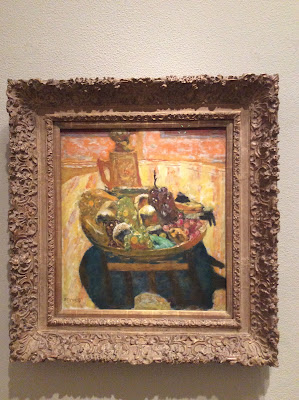The impossible distances between you and me: on perception
 |
| Pierre Bonnard, Still Life, 1933, Oil on canvas, 57.9 x 53 cm, Philadelphia Museum of Art |
Then, almost a year ago, on April 5, 2018, I looked at the painting again closely, and I saw something completely different:
A page from my sketchbook at the time.
I noticed that in the Bonnard still-life, the stripes of the table cloth took a different direction in the shadows of the fruit platter. This change in direction and velocity gave the painting a lot of tension. When people talk about Bonnard, it is in this rather trite hedonistic, very earthly pleasure sort of way, as if Bonnard was only inspired to paint pretty paintings with luxuriant colors, and nothing more. The still-life in Philadelphia was anything but simply pretty. The whole painting is full of tension and contrary to the usual opinion on the matter, it is not decorative but potently explosive.
Anyway, I wanted to create a painting with a direct quotation of this change in direction of the table cloth and with the same tension or at least an attempt to create the same tension.
 |
| Roy Forget, “Bay View,” 2018, Oil on two canvas boards, 46 x 66 cm. |
“Bay View” is not truly a small study of the larger “La Lumière Inépuisable” as they were worked on contemporaneously, going on a similar path, but taking on completely different directions at the end. The idea of the deflected stripes in the shadows of Bonnard’s still life were the starting point of the two, but as the paintings evolved, the smaller piece kept its simplicity, and the larger one became more and more baroque in its necessity, and perhaps, the complexity consumes a bit of the quiet contemplation that the smaller piece enjoys.
Earthly pleasure is full of hidden sweat and pain and the melancholy of epicurean philosophies is inherent and definitive. I really don’t think Bonnard or Matisse, the two who suffer the most from the simple-minded, degré zéro, reading of their painting based on a simplistic notion of hedonistic pleasure, should be taken at face value, simply because in their paintings, there is always tension and what one would call anxiety or doubt. A French word that works well to describe this is “gêne,” (“annoyance” could be a possible translation).
 |
| Roy Forget, “La Lumière Inépuisable,” 2018, Oil on linen, 89 x 116 cm |
The larger “La Lumière Inépuisable,” likely exhibits this “gêne” more apparently than its smaller counterpart. That large oversized table, like some sort of barrier reef that is the threshold of a deep fall off into an oceanic trench, where one tectonic plate subducts or slides under another one, and those two figures, so backlit, one wonders if they are not illusions or ghosts, which they may be, and that reflected red light in front of the plate of grapes, like a small internal combustion, waiting to consume the burning lanterns above, and the whole painting itself.
I was asked at the opening last evening by a stranger if the painting was based on holiday photographs. I guess that the notion of a seaside, a bay, outdoor picnic table, fanciful lanterns, over-ripe fruit, all want to signify leisure and pleasure. The possibility of leisure and pleasure definitely is not discarded, but perhaps the real idea behind these two paintings is a certain “regard sur l’ennui.” The moment we all have experienced, where the past is painfully present, where the present is anxiously unaccountable for, and the future neither imaginable nor wished for.
* * *
The direction of La Belle Hortense confirmed the prolongation of my show there for the entire month of January, so instead of having just until January 15 to get a bit annoyed by my paintings, you have until January 31.



Comments
Post a Comment